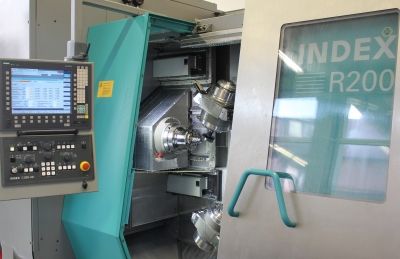Index 'Bevel Gear Hobbing Package' Produces Gears With Tooth Height in a Module Range of 0.6 to 4 mm
Index recently developed a “bevel gear hobbing” package, which consists of a control cycle and four Index cutter heads with module-dependent inserts. Equipped with these features, the Index R200 and Index R300 turn-mill centers become gear cutting machines on which spiral bevel gears can be produced from bar stock, with front and rear end machining, complete in one setup or as a pure two-spindle gear cutting machine.
By hobbing using a continuous indexing method – which corresponds to the Klingelnberg Cyclo-Palloid method – spiral bevel gears can be produced with constant tooth height in a module range of 0.6 to 4 mm.
Compared to the conventional process chain with classic gear cutting machines, users can achieve shorter cycle times and better geometry and position tolerances. And it is designed to be more flexible.
“The starting point of the development by Index lies in its own manufacturing governed by the principle: quality-determining components are made in-house,” said Dr. Volker Sellmeier, Index-Werke’s head of technology development. “When the tool holder production was reorganized several years ago, the decision was made to produce the required bevel gears ourselves.”
Due to their static, dynamic and thermal properties, the turn-mill centers of the Index R-series are suited to gear-cutting, provided they are equipped with the “bevel gear hobbing” technology package. The R machines’ axis configuration with two milling spindles on Y-B-axes running in hydrostatic bearings makes it possible to machine on the main and counter spindle simultaneously in five axes.
The turn-mills’ ability to complete gear-part machining on the front and rear ends simultaneously is meant to shorten total cycle times and lower cost per piece.





